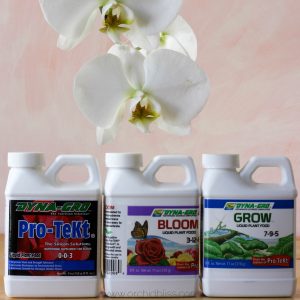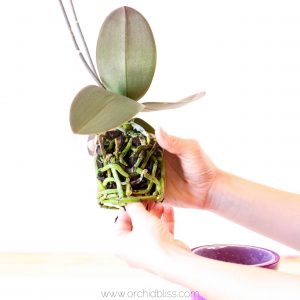Learn how to water correctly and you’ll avoid the #1 cause of orchid death
I have experimented with lots of different ways to water orchids. Learning how to properly water orchids took a lot of experimentation and fine-tuning. Don’t be surprised if it takes a while to get it right, but don’t give up.
To master watering orchids, it is essential to water from above with fresh, pure water. For orchids with water storage, pseudobulbs, water when the potting mix is approaching dry. Otherwise, for orchids without water storage, and without pseudobulbs, keep the potting mix barely damp.
Knowing when and how to water orchids is an important factor in becoming a successful orchid grower. This article unlocks effective watering techniques.
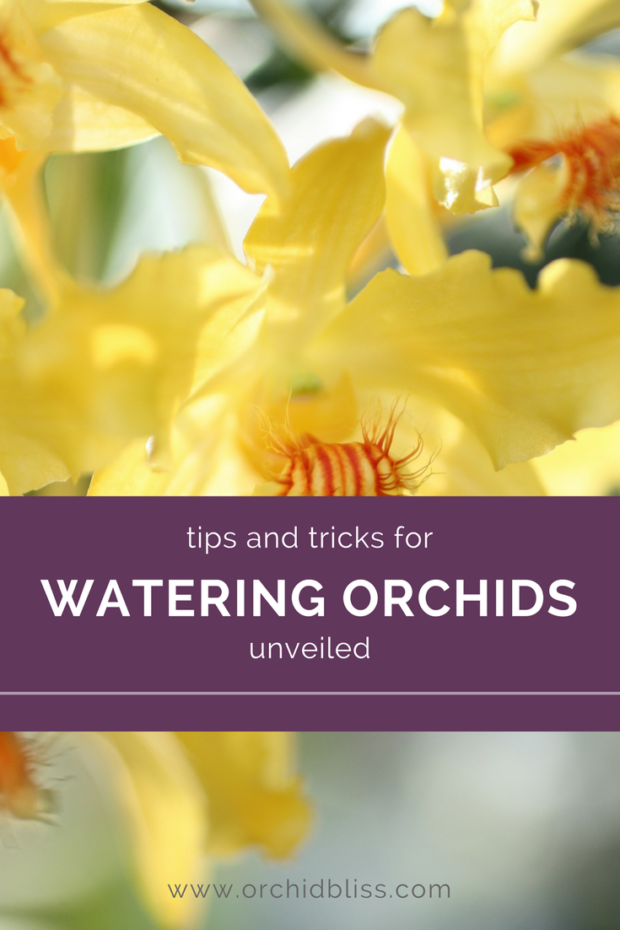
Some of the links on this page may be affiliate links. Click here to learn more.
FREE CHEAT SHEET – Tips for Watering Orchids
If you need help watering your orchids, CLICK HERE to access your FREE cheat sheet.
Despite Popular Advice – Do Not Water Orchids with Ice Cubes
Using ice cubes to water orchids came about as a means to prevent overwatering. The downside is that it can instead lead to underwatering. Besides, freezing temperatures, in the form of ice cubes, are not orchid-friendly. The orchids that most of us grow are tropical plants.
How to Water Orchids in Moss
Sphagnum moss is absorbent – very absorbent. The danger is that by soaking an orchid potted in moss in water the inner core of the moss stays constantly wet, resulting in rotted roots.
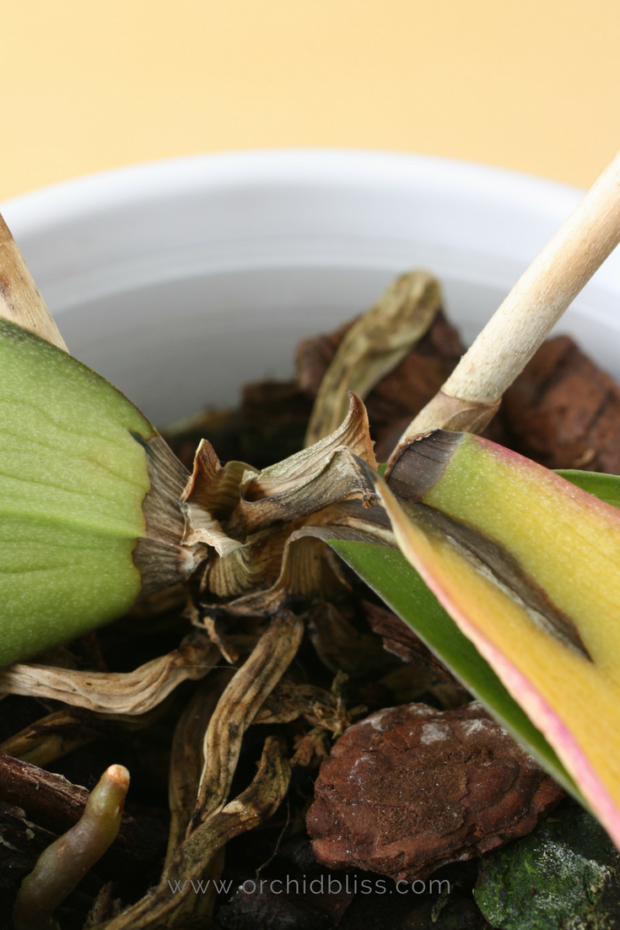
How to Water Orchids in Moss Without Using Ice Cubes
TIP: Because Phalaenopsis orchids do not have any water storage they like their potting medium to be slightly damp. If the moss is even slightly squishy it is moist.
If you are growing Phalaenopsis orchids, the best way that I’ve found to grow them in moss is to pot them kokedama style. This is going to sound really strange, but when I pot kokedama style I wrap the roots around a Wiffle ball, then I loosely wrap sphagnum moss around the roots.
The Wiffle ball eliminates the problem of having a rotted, wet center. This way the moss provides a layer of moisture around the roots, not a thick ball. I’ve had a lot of success growing Phalaneopsis orchids kokedama style wrapped in moss with a wiffle ball center.
If your orchids are potted kokedama style with a Wiffle ball center, you can soak the kokedama in water and you won’t have to worry about rotting the roots. To water, wait until the ball feels almost hard, and then set the kokedama in a bowl of water. Several minutes later the moss will have absorbed the water.
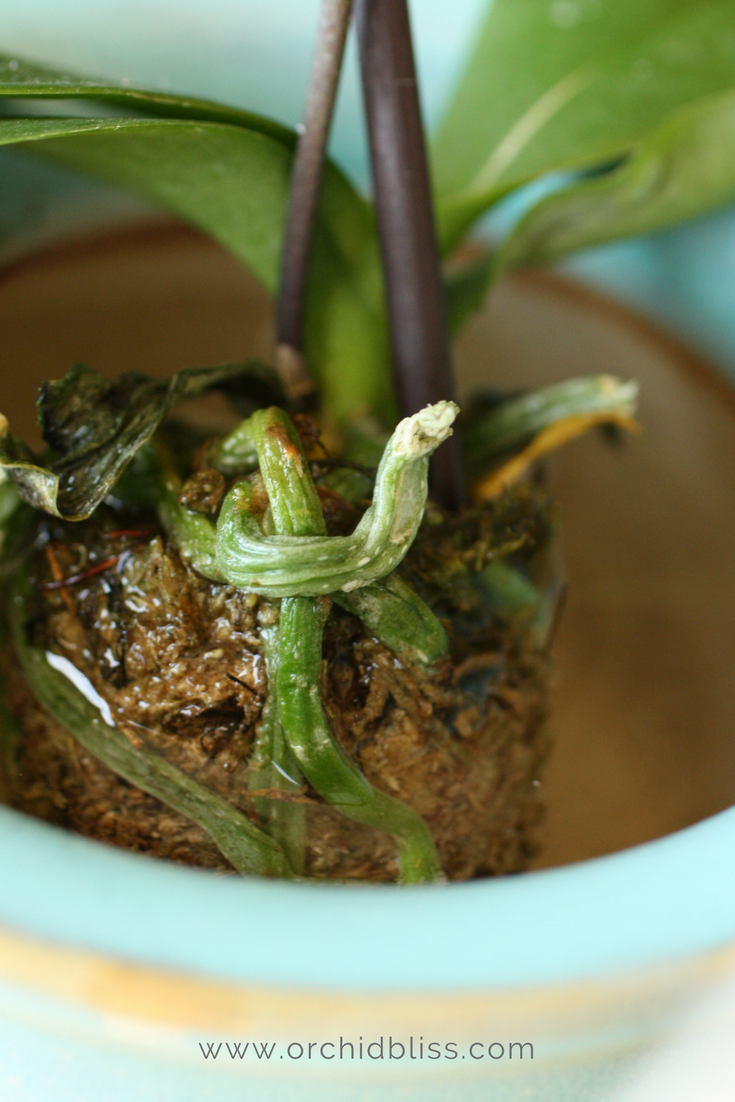
How to Water Orchids In Bark
Monterey pine bark is a popular potting medium because it is well-draining. If there is one thing that orchids don’t like, it is sitting in water. Bark prevents this problem.
There are at least two ways to water orchids that are potted in a bark-based potting medium, watering from below and watering from above. No matter which way you water–from below or above–if you pot in bark, be sure that when you water, water copiously.
The right potting mix is one of the most important parts to growing happy orchids. I highly recommend an orchid mix from rePotme.
What I really love about rePotme is that you can get a customized potting mix for many favorite orchid varieties, including phalaenopsis, cattleya, dendrobium, paphiopedilum, and phragmipedium, cymbidium, and even jewel orchids.
If you live in a dry climate, as I do, add a couple of cubes of wool rock to the potting mix to increase water retention.
Remember: proper drainage is the most important element of an orchid potting mix. It is essential that the orchid gets good drainage and doesn’t say wet in the middle. In fact, orchids are potted in tall, narrow pots so that the center of the pot dries quickly.
Watering Orchids from Below
To water your orchid from below, set the orchid in a water-filled pot. This way the orchid roots soak up the needed moisture while keeping the crown, which is prone to rot, dry.
If you decide to use this method and water from below, prevent disease by using the same pot with the same orchid each time you water. Be sure to clean the pot after use.
TIP: Oncidiums especially benefit from being watered from below as these orchids are prone to leaf spotting. Keeping their leaves dry helps to prevent bacterial growth on their leaves, resulting in spotted leaves.
Watering Orchids from Above
To water orchids potted in bark, another method is to water from above by watering your orchids from the faucet. When using this method be sure to use a drain catch for any escaping wood chips. Also, avoid soaking the orchid’s water-sensitive crown.
The biggest benefit of this method is that it is an excellent way to flush the orchid potting medium of fertilizer salts. Even if watering from above using a faucet isn’t your primary means of watering, it is good to use this method at least monthly to flush the salts.
When watering from above, use extra care to avoid water accumulating in the crown (the place where the leaves attach to the stem). Water sitting in the crown leads to crown rot. After watering, use a Q-tip, or a cloth to absorb any water accumulation around the crown.
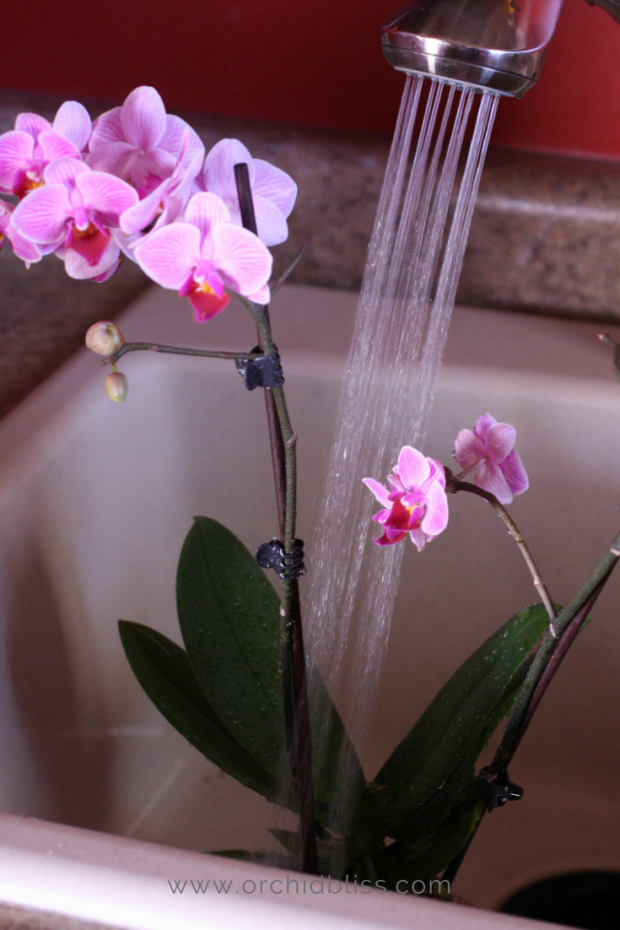
If you find that the faucet is too messy, use a narrow spouted watering can, to avoid the water-sensitive crown.
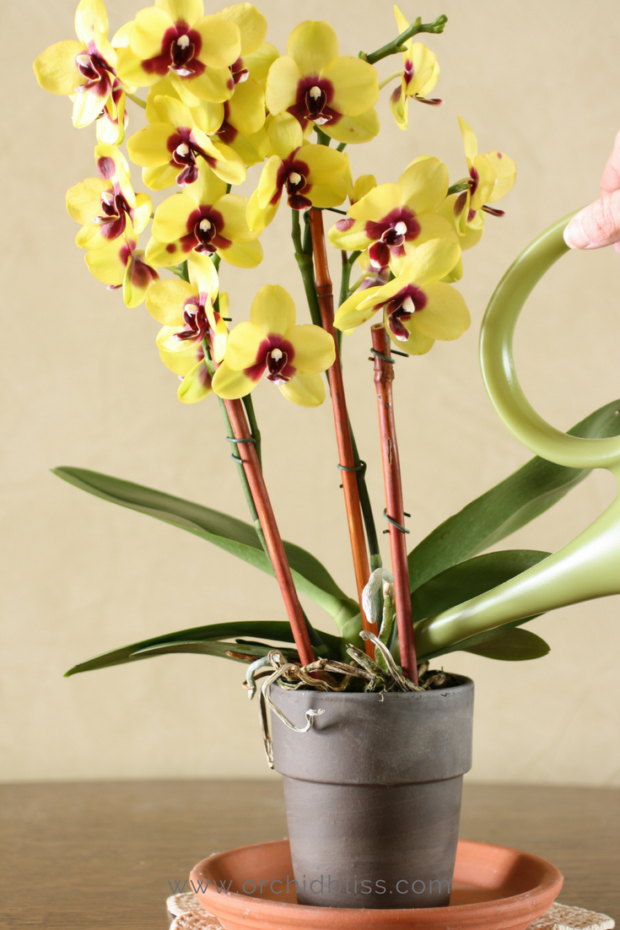
A Few Tricks to Determine When to Water Orchids (and When to Hold Off)
Time of Day Matters
Always water your orchids in the morning. This gives the crown time to dry off during the day before nightfall and prevents crown rot.
Finger Test
Before watering your orchid, check the moisture content in the pot. To tell if the orchid has sufficiently dried out, stick your finger in the growing medium if it feels almost dry, it is time to water. If you don’t want to stick your finger in the growing medium, stick a toothpick or chopstick in the medium and leave it there for five minutes. Then take it out and see if it is wet.
Drainage Hole
Look at the drainage hole and check to see if the planting media is dry. If your plant sits in a clear plastic pot that is set inside another pot, gently lift the plastic pot out of the secondary pot and look through the plastic to inspect the planting media. If there is a hole in the bottom poke your finger through and feel for any dampness.
Heft the Pot
As you become more experienced, you will be able to tell if the plant needs water simply by lifting it. If it feels light, water it.
Condensation
If your orchid is in a clear plastic pot, it is easy to check for condensation on the sides of the plastic. Wait until there is only a little water condensation to water a Phalaenopsis or Paphiopedilum. Wait until there is no water condensation to water an orchid with pseudobulbs, such as a Cattleya, Dendrobium, or Oncidium.
Pseudobulbs
Many orchid varieties have water storage in the form of pseudobulbs, such as Cattleyas and Dendrobiums, and want to dry out between watering.
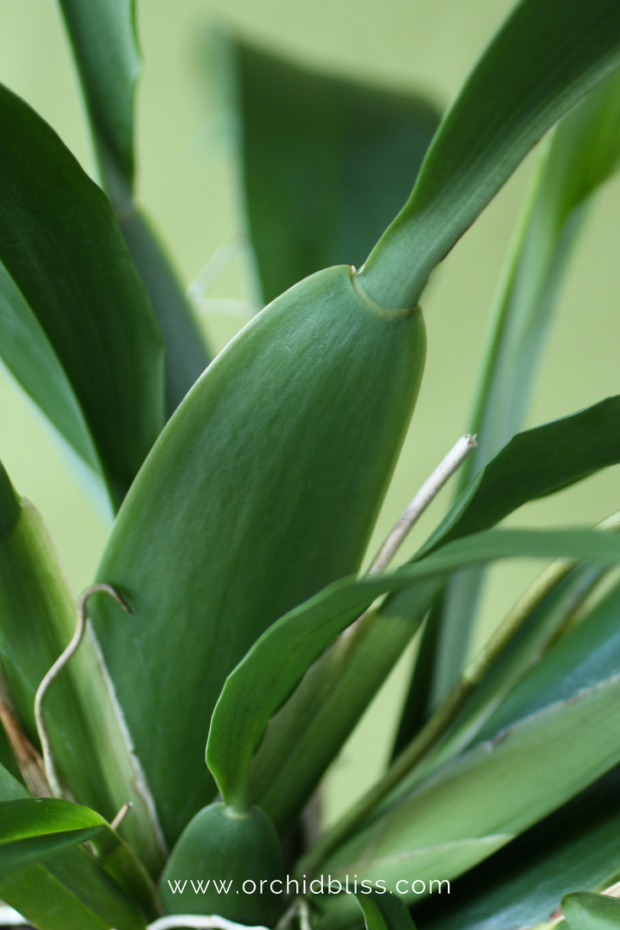
How to Water Orchids with a Self-Watering Planter
Another method for watering orchids is with a self-watering pot. This method works best with orchids that need a barely damp (never soggy) potting mix, such as the Phalaenopsis orchid. I wouldn’t recommend using a self-watering pot for orchids that need to dry out between watering, such as a Cattleya or Dendrobium.
Recently, I tried out a pot from PlanterHoma. As I haven’t used the pot before, I could only comment on the ease of use and the design., both of which are impressive. With this pot, a clear pot sits inside a larger pot that holds the water. Then, a thick string loops through the inside pot and wicks water up to the orchid’s roots.
I’m really excited about these pots and what they can do for orchid growers. Especially for people who travel a lot and aren’t available to water regularly and for new growers, as figuring out watering can be tricky. These pots are reasonably priced at $8.99 USD. If I could make a request, it would be that the pot came in multiple sizes. Click here if you are interested in checking out the PlanterHoma self-watering pot.
Answers to frequently asked questions about watering orchids:
How Much Water Do You Give an Orchid Plant?
The amount of water you give an orchid depends a lot on the potting medium. Sphagnum moss retains moisture. That’s where the ice cube idea came from. Ice cubes prevent orchid growers from overwatering.
Rather than relying on ice cubes to prevent watering, use the above strategies to determine if your orchid needs water.
If your orchids are potted kokedama style, with a Wiffle ball, as mentioned above, you can soak the kokedama in a bowl of water.
Monterey pine bark is well-draining and doesn’t hold much water, especially if the bark is fresh. Over time, as the bark begins to break down, it becomes more absorbent. Because it is so well-draining, when using bark, water copiously when watering, then allow the water to drain.
A lot of orchids, such as cattleyas and dendrobiums, like to dry out between watering and bark allows them to do that. I grow all my cattleyas in bark, and they do really well. I flush them in water and let them drain. Within 7 days, I water them again.
What About Watering Orchids in Winter?
You can tell if your orchid requires a dormant period because these orchids are deciduous, meaning they lose their leaves in the fall and grow new leaves in the spring. If this is the case, occasionally, give the orchid a heavy misting. While dormant, the orchid will look like it is dead but don’t despair. Come spring the orchid will wake up and rejuvenate. Orchids that require this extreme period of dormancy include Catasetum, Cycnoches, and some Dendrobiums and Lycastes.
To slowly wake up a dormant orchid, give it a good soaking around Valentine’s Day and then let it dry out again over the next several weeks.
If your orchid is evergreen it may still benefit from a reduction in water during the winter months. For example, if you were watering weekly during the summer, water every 10 days in winter.
Orchids that benefit from reducing water (include: Some Dendrobiums, some Cattleyas, most Bulbophyllum, and most Coelogynes.
As Phalaenopsis, Vandas, and Paphiopedilums do not have water storage in the form of pseudobulbs, continue to provide adequate water for these orchids. Though as temperatures cool the rate they absorb water will lessen.
TIP: When purchasing a new variety of orchid, ask the seller if it is evergreen or deciduous. If it is deciduous, you’ll know that it will need a winter rest. Ask the seller what the recommended winter care is for that orchid.
What About Watering Orchids In Bloom?
Regularly water orchids that are blooming, growing new roots, or new leaves. While some orchids such as Cattleyas and Dendrobiums like to dry out between watering, others such as Phalaenopsis and Paphiopedilums like to remain evenly moist.
Evenly moist is an elusive term. The best way I know how to keep an orchid evenly moist is to grow them in a clear, plastic pot. This way I can keep an eye on the potting media and the roots. Water condensation on the sides of the pot is a key indicator the orchid is moist. I wait to water until most of the water condensation has been absorbed before watering again.
I would also like to add a word about what it means to allow orchids to dry out between watering. For orchids that like to dry out, I recommend potting them in fir bark. This is a well-draining potting mix that allows you to give the orchid a good soaking but does not retain a lot of moisture.
How do I know if my Phalaenopsis is getting enough water?
You will know if your Phalaenopsis is getting enough water if the leaves are upright and stiff. The roots will be bright green when wet with green or magenta tips. When dry, the roots will be silvery. Wet or dry, the roots will be firm and plump.
An overwatered Phalaenopsis will have mushy roots that have turned black or brown. The roots will be floppy and lifeless. The leaves will droop and will be leathery and floppy.
An underwatered Phalaenopsis will have dry, brittle roots and the leaves will be similar to those of an overwatered Phal, droopy, leathery, and floppy.
TIP: Don’t let aerial roots trick you into thinking your Phal is under-watered. Look to the potting medium, the roots growing down in the potting medium, and the leaves as watering indicators.
When to Water – In a Nutshell
More orchids are killed by overwatering than by underwatering. When in doubt, wait a day or two. Another consideration that greatly influences watering and overall plant health is the growing medium for orchids.
Sphagnum moss soaks up and retains moisture, so orchids potted in this medium need less water, less frequently. Orchids potted in fir bark need more water more frequently.
During winter months, transpiration, or the rate that orchids breathe, slows down. Resulting in a need for less water.
During active growth and when the orchid is flowering, water your orchids regularly as needed.
When watering, let your orchids be your guide, not your own timetable and your orchids will flourish.
FREE CHEAT SHEET – Tips for Watering Orchids
If you need help watering your orchids, CLICK HERE to access your FREE cheat sheet.
Water Quality and Orchids
If you just want to keep your orchid alive, the above information is all you really need.
If you are still mastering how to water your orchid, figuring out light and tinkering with temperature for your orchid, just bookmark this page and come back when you’ve got those three pillars of orchid care mastered. But, if you’re ready to level up watering your orchids, let’s talk about water quality.
Why Water Quality Matters to Your Orchid
Orchids growing in their natural habitat are watered with pure rainwater, which contains very few minerals and salts. Orchids are ill-suited for anything less. This is true for both epiphytic orchids that grow attached to trees and semi-terrestrial orchids that grow on the ground.
Take Paphiopedilum orchids, for example. If you grow slipper orchids and they aren’t doing well, improve the quality of their water, and you’ll see a marked improvement.
Orchids are adapted to pure, clean rainwater.
Though just to be clear, rainwater does contain some dissolved solids and does absorb some pollutants. It is far purer than groundwater.
What’s So Special About Rainwater?
Rainwater, unlike groundwater, does not contain a lot of dissolved solids. Most dissolved solids are some form of salt
- Bicarbonates
- Sulphates of sodium, calcium, magnesium, potassium
- Chlorides
Along with the dissolved salts, groundwater also contains small amounts of dissolved organic matter. On water quality reports these dissolved components are recorded as total dissolved solids (TDS) (kind of sounds like a disease) and are expressed in a percentage of part per million (ppm).
Along with containing low amounts of TDS, rainwater has a pH lower than city water as chlorine is added to most city water.
Let’s Talk About pH
pH is a measurement of acids and bases expressed on a range between 14 (most basic) and 0 (most acidic) – 7 being neutral. Orchids prefer a reading between 5.5 and 6.5. Each number is 10 times more acidic, or basic, than the next.
To be more specific, bases and acids differ in the amount of free hydrogen and hydroxyl ions that are in the water. The more free hydrogen ions the more acidic the water. The more free hydroxyl ions are in the water, the more basic the water.
NOTE: As an example, rainwater pH varies across the US between 4.3 and 5.3, much lower than many cities with tap water with pH readings as high as 8 (See usgs.gov).
The bottom line is that for most of us, the water that comes from our taps is not ideal for watering orchids. This is because tap water and even spring water contain high amounts of salts and minerals, and if you’re on city water, chlorine.
IMPORTANT TIP: Whatever water you use, do not use softened water as it contains high salts that will quickly kill your orchid.
How to Find Out About Your Water Quality
The first step is to determine your water quality, specifically the amount of TDS and the pH. If you are on municipal water, you can:
- Look it up online.
- Call/email your water conservation district.
If you are on well or spring water, you can buy a TDS meter and pH strips – or even a digital pH meter.
Ideal TDS and pH Ranges for Growing Orchids
The next step is to compare your reality, your tap, well, or spring water with ideal, or even tolerable, TDS and pH levels for growing orchids.
- Ideal TDS: less than 100 parts per million / <100ppm
- Okay TDS: 100-200 ppm
- Unacceptable TDS: >300 ppm
- Ideal pH range: 5.5-6.5
How to Improve Water Quality
If you’ve discovered that your water quality doesn’t measure up, your best options are to either collect rainwater or improve your tap water. Or, you can move to a location with better water quality. Just kidding.
How to Collect Rainwater
To harvest rainwater, simply place a container, this can be a large barrel, under a downspout that runs off your roof. You will also need a pump to get the water out of the container and into a water pitcher.
Using rainwater is the most environmentally conscious choice as there is no waste, as there is reverse osmosis (described below).
Improving Tap Water
Here are a couple of ways you can improve the quality water of your tap water. The first solution works best if you grow only a handful of orchids. The second solution is an investment you may want to consider if you are unable to collect rainwater and grow a large selection of orchids.
Mix Distilled Water with Tap Water
If you are growing only a few orchids, here is an easy way to improve your water quality. Mix distilled water with tap water. Test a 1:1 blend and see what your TDS and pH levels are. Though a few adjustments may need to be made, 50/50 is a good starting point. If you are growing lots of orchids, you may need to use another method.
Reverse Osmosis (RO)
Reverse Osmosis is simply a water filtration system where water is forced through filters leaving the dissolved solids behind and the pure water passes into a collection tank. The dissolved solids go on to the sewer, septic, or groundwater – however, you dispose of water. This means that inevitably, there is some water waste.
Because RO water is so pure, minerals and fertilizer, needs to be added back into the water. Before using RO water, test it to be sure you have enough dissolved solids that it is safe for your orchids.
Adjusting pH
To get a pH reading use a measured amount of a large quantity of water, such as a 10-gallon barrel, mix in your fertilizer specific to the volume of water, then take the pH reading.
To adjust acidity, use a few drops of citric acid or pH Down. To make the water more basic, use potassium hydroxide or pH Booster.
When balancing pH, only use a few drops, let it sit for a few hours, then take another reading.
The easiest way to test pH is to buy litmus strips or water quality meters.
Fine-Tuning Water Quality for Your Orchids
After choosing the water purification method of your choice: collecting rainwater, mixing tap water with distilled water, or implementing an RO system, you need to test, both for TDS and pH, before using it on your orchids to be sure it falls within acceptable ranges.
Then, for the most accurate results, test the water again after it has run through your orchid’s potting media. In other words, test the water that runs out of your orchid’s drainage hole. The media that your orchids are potted in will impact the quality of the water.
You wouldn’t be reading this if you didn’t love your orchids. Fine-tuning water quality is a serious business, but it isn’t anything you can’t handle.
FREE CHEAT SHEET – Tips for Watering Orchids
If you need help watering your orchids, CLICK HERE to access your FREE cheat sheet.
Ready to Learn More?
To help you further, start by downloading my free cheat sheet to see where to cut the orchid flower spike after the blooms have faded to trigger re-blooming. Click here for the cheat sheet. It’ll be super helpful.

